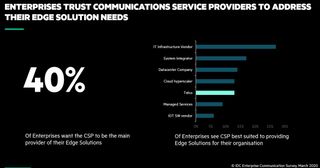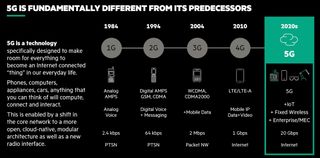HPE enables telcos to drive new revenue streams from edge of 5G networks
Edge Orchestrator will help operators tap into new digital business models and play an important role in evolving enterprise ecosystems

Hewlett Packard Enterprise (HPE) is unleashing new revenue options for telecom operators in the enterprise market with one-click deployment of apps at the edge of 5G networks.
With its Edge Orchestrator solution, the US company is putting CSP in a unique position to monetise 5G networks and edge infrastructure by delivering new low latency cloud services, increased security and enhanced end-user experiences at the edge via an app catalogue.
Major technology companies are now shifting focus to the edge of the networks.
HPE in March launched its standalone 5G core stack through its cloud-native and multivendor interoperability solutions.
One week ago, Aruba, a Hewlett Packard Enterprise company, launched its edge services platform for organisations to innovate more effectively, informed by growing volumes of data analysed at the edge of networks.
In March, Microsoft introduced Azure Edge Zones and Azure Private Edge Zones; Google Cloud partnered with AT&T to release several 5G edge-computing solutions; and IBM announced edge services, run on Red Hat OpenShift, in May.
According to research firm Gartner, 75% of the data will be generated and processed at the edge by 2025 from just 10% in 2018.
Are you a pro? Subscribe to our newsletter
Sign up to the TechRadar Pro newsletter to get all the top news, opinion, features and guidance your business needs to succeed!
“Today, telcos have significant enterprise business, but they are often seen as little more than bandwidth providers, competing mostly on price,” said Phil Mottram, Vice-President and General Manager of the Communications and Media Solutions business unit at HPE.
Analysts expect the next decade to see the rise of edge computing where data-intensive workloads such as AI, machine learning (ML), augmented and virtual reality apps will be hosted at the edge.
Telcos already have thousands of edge sites powering mobile and fixed networks, so they are uniquely positioned to lead the edge services market.
Telcos need to revamp

According to a recent IDC study, 40% of enterprises trust their telco to be their main provider of edge solutions.
However, until now telcos haven’t had the tools to do it themselves without relying on public cloud providers.
“Telcos are uniquely positioned to facilitate digital change by connecting people, enterprises and society, enabling new classes of services,” Martina Kurth, Associate Vice-President for IDC’s European Telco Research, said.
“Telcos need to change the way they operate and become part of the value creation with 5G and edge computing. New technologies like HPE Edge Orchestrator will help telcos to tap into new digital business models and play an important role in evolving enterprise ecosystems.”
Mottram said that HPE Edge Orchestrator empowers telcos to move up the value chain and become trusted edge services providers, offering differentiated, high-value enterprise services as well as new edge applications for their mobile subscribers.
Moreover, he said that telcos will be positioned to compete more effectively with cloud and over-the-top competitors.
HPE Edge Orchestrator will be available as software-as-a-service from July 31, 2020.
It supports multi-access edge computing (MEC) with other network-as-a-service (NaaS) functions being added to the catalogue over time.

Going forward, Mottram said that telecom vertical will become a key growth pillar for HPE, prompted by 5G, edge computing, AI and automation.
Rolf Eberhardt, Head of Service Orchestration at HPE, said that telcos need to bring applications from the cloud out to the edge where the data exists to capitalise on the edge services opportunity.
“We want to make CSPs to efficiently allow enterprises to deploy their own applications and at their own locations and can move from being primarily bandwidth providers to offering innovative edge computing applications, such as AI-powered video analytics, industrial automation and VR retail services,” he said.
Moreover, he said that new revenue from these high-value enterprise services will also help to cover the significant cost of deploying new 5G infrastructure.
Most Popular



